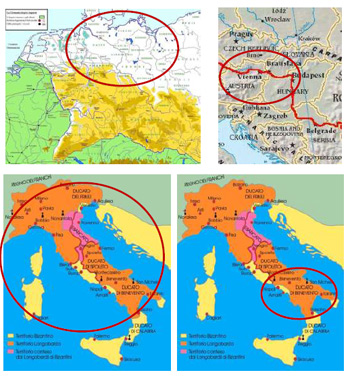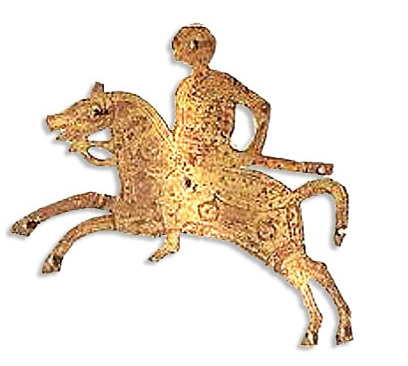Macro-areas structure
The cultural route Longobard Ways across Europe is based on the various roads and on the geographical and historical-cultural coordinates of the territories where the Longobard peoples passed and settled during their epic migration - from the seas of the North to the Mediterranean - in 10 present-day European countries (Germany, Czech Republic, Slovakia, Austria, Hungary, Slovenia, Italy, Switzerland, Croatia and France).
The articulation of the European Route is structured in four macro-areas, each corresponding to specific phases in the development of Longobard civilizatio
- the North European phase; macro-area defined “Lands of the Elbe”;
- the Central European phase; macro-area defined “Lands of the Kings“;
- the Italian phase of the Kingdom; macro-area defined “Lands of the Kingdom”;
- the Mediterranean phase; macro-area defined “Lands of the Princes”.
Each macro-area is divided into homogeneous territories defined as “Tourist Clusters” where there are specific historic-archaeological, naturalistic and traditional evidences that characterize the identity of each single Cluster.

FIRST MACRO-AREA / “LANDS OF THE ELBE” MAP
The first macro-area – with the respective tourist Clusters- extends along the final stretch of the river Elbe. These locations with their striking landscape (the areas of the present Länder of Niedersachsen, Schleswig-Holstein, Mecklenburg-Vorpommern) witnessed the formation and first development of the Longobard people (1st BC- 4th century AD), followed by their passage from sedentary farmers to nomadic warriors.
The areas of discovery of indicative finds, that is of archaeological finds recognized as Longobard material culture, include the territories of 9 Länder, 63 Districts and 2 City-States (Hamburg and Berlin).
The Longobards settled in these sites with their striking landscapes after having left the mythical Scandinavian region of Scandanan (Scania) and after stopping in Scoringa (perhaps the island of Rügen).
These areas were shared or disputed — from the 1st century BC — with other Germanic populations, hence the necessity for the Longobards to put farming activities and the divinities associated with them into second place and become warriors, also adopting new gods from the Nordic pantheon — in particular Wotan-Odin — more suited to protecting them in their prevalent new activity.
FOCUS POINTS:
- Niedersachsen: Stade, Lüneburg, Hamburg-Harburg, Bardowick, Kalkriese,
- Mecklenburg-Vorpommern: Hagenow, Ludwigslust, Schwerin
Between the 3rd and the 4th century AD, the Longobards, in search of new lands, began to move slowly up the Elbe (Sachsen-Anhalt, Brandenburg, Sachsen) towards Central and Eastern Europe. This phase was preceded and marked by the participation in Germanic alliances engaged in armed clashes against the Romans and against other peoples as well as, in the 5th century, by the struggle to free themselves from the dominion of the Huns.
SECOND MACRO-AREA / “LANDS OF THE KINGS” MAP1 MAP2
The path of the Longobards through history then developed (end 5th- 6th century) until they settled along the Danube and, in particular, in a macro-area that includes the present-day territories of Czech Republic, Slovakia, Austria, Hungary and Slovenia. Here, after defeating powerful peoples (the Heruli and the Gepids), the Longobards encountered the Byzantine Empire and Arianism, confirming their status as a powerful new domain.
This area – with the respective tourist Clusters - includes the territories that were once part of the old Roman provinces of Pannonia Secunda and Valeria and through which the migration passed on the way to the Pannonian area, where the second period of permanent settlement of the Longobards is recorded.
FOCUS POINTS:
- Czech Republic/ Brno, Znojmo, Prague;
- Slovakia/ Bratislava;
- Austria/ Wien, Mödling, Tulln;
- Hungary/ Györ-Sopron, Vàrpalota, Budapest;
- Slovenia/ Kranj, Ljubljana, Nova Gorica
During the period of settlement in these areas - lying between the Danube, its tributaries and Lake Balaton - a profound phase of political transformation of the Longobard peoples occurred: a form of hereditary monarchy was established, able to relate to the great powers of the time (the Empire of Byzantium, the Gepids, Avars, Franks and Bavarians) and to promote matrimonial policies of a dynastic type and strategic alliances. This prerogative justifies the title “Lands of the Kings” given to the second macro-area.
In this phase the Longobards encountered Roman-Byzantine culture, the Arian form of Christianity, the traditions and cultural expressions of the Slav peoples and of the Asian Steppe.
 THIRD MACRO-AREA / “LANDS OF THE KINGDOM” MAP1 MAP2 MAP3
THIRD MACRO-AREA / “LANDS OF THE KINGDOM” MAP1 MAP2 MAP3
The extension of the third macro area – with the respective tourist Clusters - is based on the period of the Longobard Kingdom of Italy - hence the title of the third macro-area - between 568 (year of the invasion by the Longobards led by King Alboin) and 774 (year of the defeat of the last Longobard king Desiderius by the Franks of Charlemagne, resulting in the end of the Kingdom).
In Italy, after the initial decades of the settling period, Longobard culture produced highly important results, especially from the institutional point of view. The monarchy reached a territorial dimension; the government of the territory took shape with the creation of about 30 duchies and, within these, of countless minor divisions entrusted to representatives of the kings (gastaldi); the far-seeing action of Queen Theodelinda launched the gradual acceptance of Roman Catholicism by the Longobards, perfected at a later date, and the reconciliation of the Schism of the Three Chapters, favouring the unification of the Western Churches under the apostolic Church of Rome.
The third macro-area includes the territories of 18 Italian Regions and, in them, countless large and small towns as well as a series of rural centres.
FOCUS POINTS:
- Capitals: Verona, Pavia, Milan, Monza;
- Duchies: Cividale del Friuli (first duchy), Ceneda, Treviso, Vicenza, Verona, Trento, Brescia, Bergamo, Turin, Asti, Ivrea, S.Giulio (Novara), Genoa, Piacenza, Parma, Persiceto, Reggio, Tuscia, Chiusi, Fermo, Spoleto, Benevento, Salerno, Capua.
- Gastalds: Towns of residence of the officials who administered the properties of the Longobard king
FOURTH MACRO-AREA / “LANDS OF THE PRINCES” MAP3 MAP4 MAP5
It consists – with the respective tourist Clusters - of the territories of 7 present-day Regions (Campania, Abruzzo, Molise, Puglia, Basilicata, Calabria and part of south-Lazio) that were under the rule of the duchies of Benevento, Salerno and Capua, constituted as autonomous Principalities and heirs of the Kingdom - hence the title of the fourth macro-area - after the end of the Kingdom following the victory of Charlemagne in 774.
The fourth macro-area has quite rightly been indicated as the "Mediterranean phase" of the Route. As well as continuing the actions already undertaken for the military strengthening of the territory (by building castles and fortified sites), consolidating the support of the ecclesiastical institutions, promoting forms of worship and renewing relations with the Byzantine Empire, the Longobard princes played an important role in connecting with the new cultures: above all with Norman culture, of Nordic derivation and sharing a Saxon root, but also with Arab-Moslem culture, which had appeared on the coastal areas in the South.
New forms of culture developed in the fourth macro-area: from graphics (Beneventan script) to forms of liturgical chant; from medical knowledge (the School of medicine in Salerno) to the first examples of early Italian popular language.
IN SWITZERLAND: The Territories involved in the Longobard history are those of today Canton Ticino (Seprio's Judicaria).
IN CROATIA: The Territories involved in the Longobard history are those of Istria, conquired by Longobards (VIII sec.).
IN FRANCE: The Territories involved in the Longobard history are those of Arles in which the king Liutprand worked militarily in support of the Franks who opposed the Arab invasions (VIII sec.).
News
-
2025 24 SeptemberTra le carte della Corona
-
2025 24 SeptemberLa religiosità dei Longobardi
-
2025 21 MarchERRATA CORRIGE CONVEGNO DONNE LONGOBARDE
